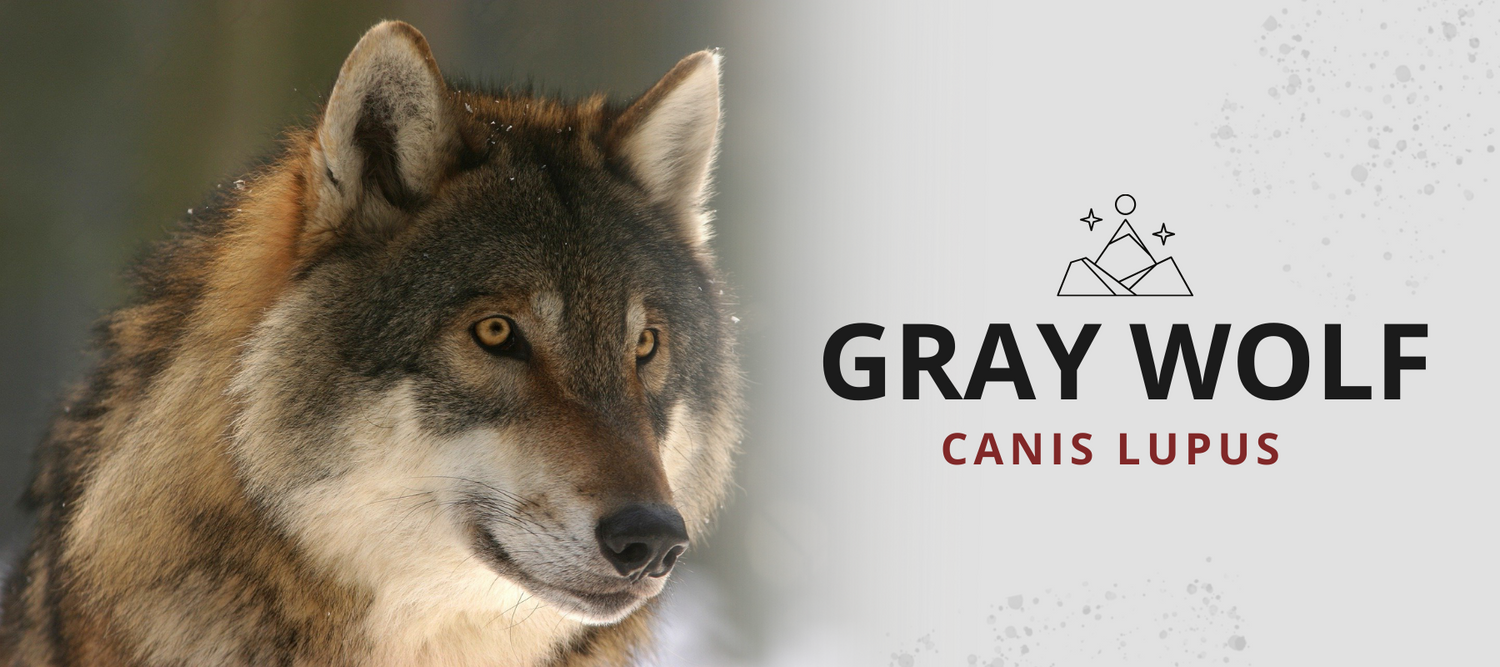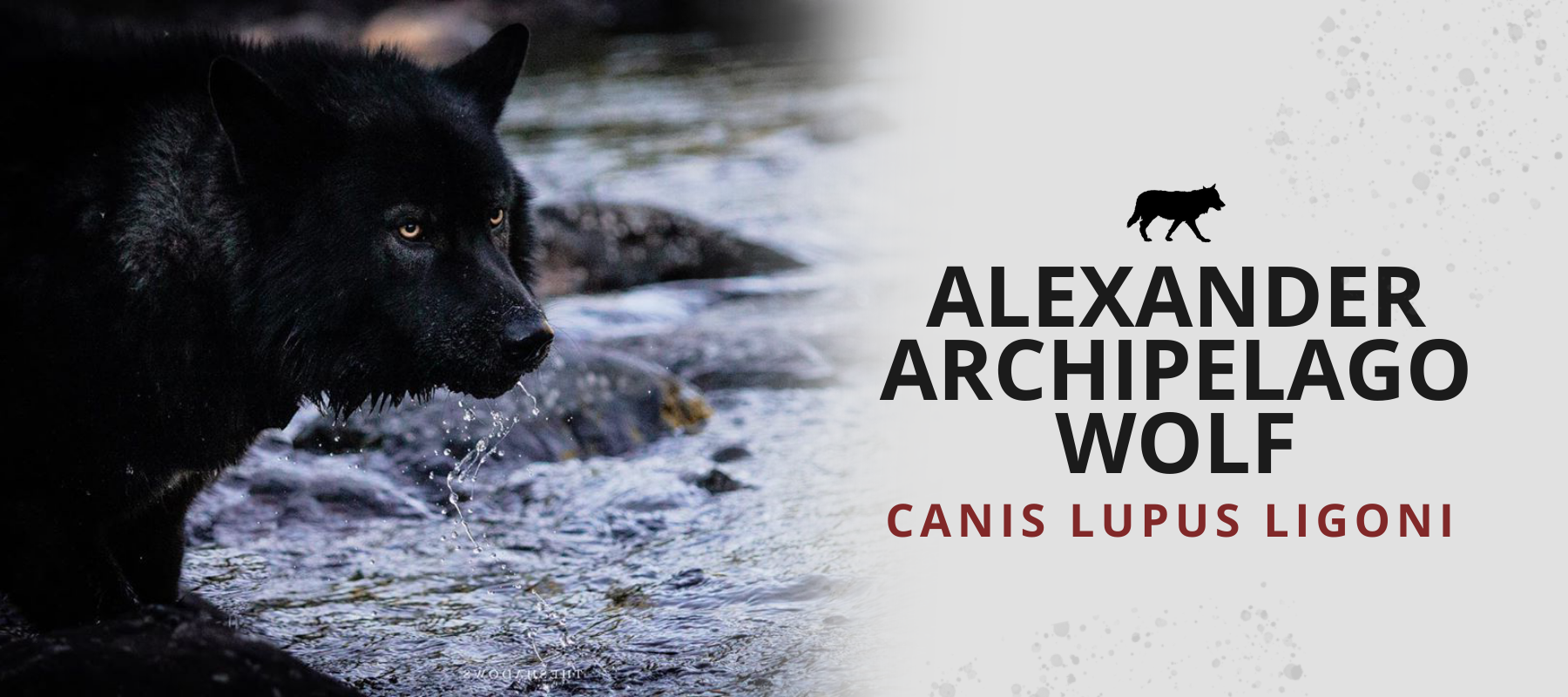
CANIS LUPUS WOLF
The gray wolf, grey wolf or Canis lupus wolf, is a carnivore belonging to the large family of Canidae in the same way as dogs, foxes, jackals, wild dogs.
Over the course of evolution, the wolf has evolved into many subspecies depending on the regions, such as the common European grey wolf (Canis lupus lupus), the only wolf species present in Europe, Arctic wolf (Canis lupus arctos), Eurasian wolf, Carpathian wolf, wolf of the steppes, Mexican wolf, red wolves or wolf of China.
Between fifteen and forty subspecies of wolves have been listed to date. The wolf was the first canid to have been domesticated by man, and it is believed that the wolf also led to the appearance of the dog (Canis lupus familiaris) 30,000 years ago.
- Common name: Gray wolf
- Scientific name: Canis lupus
- Other names: grey wolf
- Specie: Gray wolf
- Type: Mammals, canidae
- Diet: Carnivore
- Size 3,2 to 5,4 feet
- Weight: 35 to 175 lbs
GRAY WOLF DESCRIPTION
The morphology of the gray wolf can be extremely variable depending on the region of origin of the individuals.
-
Size
The male is generally more imposing than the female and can measure an average of 5,4 feet (1.65 m) in length between the tip of his tail and his snout, compared to 5,2 feet (1.59 m) for the she-wolf.
The height at the withers of individuals is between 1.9 and 2,9 feet (60 and 90 cm) for a weight ranging from 35 to 110 lbs (16 to 50 kg) for females and 44 to 154 lbs (20 to 70 kg) for males depending on the subspecies.
-
Life expectancy
Average life expectancy of the wolf is about 10 years.
-
Fur color
Wolves coat can vary from creamy brown to fawn to black.
-
Wolf teeth
The wolf's dentition appears during its 7th month of growth, first with 32 milk teeth and then with 42 teeth for an adult. Their jaws are powerful and can reach a pressure of 150 kg/cm² (compared to 60 kg/cm² for a labrador).
-
Physical ability
Wolves are also known for their capacity to easy swim and their endurance. They are among the most enduring land carnivores when it comes to running, with maximum speed up to 40 to 50 km/hour. They can cover an average of 60 km per night.
The gray wolf's senses are particularly well developed. Its powerful sense of smell can detect an animal from 270 m upwind.
Its field of vision is 250° (compared to 180° for humans). Like cats, its eyes are lined with a cellular layer, the tapetum lucidum, allowing it to have good night vision.
Gray wolves also have good hearing: they can hear sounds up to 40 kHz (compared to 20 kHz in humans) and up to 6.4 to 9.6 km away.

GRAY WOLF HABITAT
Originally, the gray wolf was the most widespread mammal species in the world. However, despite conservation efforts and recovery plan, some species have become extinct in the wild in many parts of Western Europe, Mexico and the United States, limiting their presence in the most remote and wilderness areas.
As a result, the number of wolf species has significantly decrease due to human persecution and depletion of food resources. Wolves are present in all types of natural habitats in the northern hemisphere: mountains, wooded plains, forest environments, steppes, tundra, mountains, semi-desert areas …
There are two main groups of wolves: those in the north, living in North America, Europe and northern Asia, which are larger and more powerful than the wolves in the south. The latter live in North Africa, the Arabian Peninsula and southern Asia. In fact, they are more similar to wolves living 800,000 years ago, whereas northern wolves are from a more recent lineage (150,000 years old).
Wolves prefer to settle preferentially where food resources are sufficient and where the density of large wild herbivores is high. Their presence also depends on others factor such as climatic conditions. Wolves are indeed able to regulate their body temperature with a specific variation in blood flow through the skin and pads. The distribution of wolves is also influenced by human presence and topography.
For their daytime rest, wolves prefer covered areas in cold, damp or windy weather, but also choose open air areas in dry, calm and warm weather. They generally build dens from natural shelters such as cracks in rocks or vegetation holes during the summer period, mainly for wolf pups. Usually built close to a water point, the den is generally south oriented to ensure optimal exposure to daylight.

GRAY WOLF BEHAVIOR
-
Social and Reproductive Behaviors
The wolf is a social animal living in a pack generally composed of a dominant alpha male and female to compose the breeding pair. The dominant couple is the only one to breed. This breeding period takes place between January and March.
Parturition takes place between March and June following a gestation period of 62 days on average. Litters may include one to eight cubs but are generally one to three cubs for young wolves, with fecundity increasing with age.
However, mortality of the wolf pups is high in the first year. They are suckled until they reach six weeks old and then, are fed with regurgitated meat. Around four months old the cubs learn the principles of submission to adults and follow their parent out of the den around one year old.
Then, they leave the family group at about two to four years old, when they must explore unknown territories and hunt alone. Triggers for the separation of young people from their families of origin are usually their sexual maturity and competition for food resources within the pack.
In the wild, wolves are sexually mature at about 22 months old. This maturity may be earlier in captivity. New packs are usually formed with an unrelated male and female who then travel together to find an area devoid of hostile packs.
Wolf packs rarely include individuals from outside the group and when they do, the new arrivals are often immature young (one to three years old) and do not represent a major rivalry for the breeding pair.
-
Territorial and dietary behaviors
Wolves are territorial animals that live within a region that varies according to the food resources found. The size of their territory varies according to the age of the cubs and the density of prey present (the older the cubs are, less prey they have, larger is the territory).
The pack is constantly on the move within its territory and travels about 9% of its territory per day (25km on average). A well-established wolf pack rarely leaves its territory or only in case of food shortages. They defend their territory by scent markings (urination, defecation, scratching the ground, etc.), direct attacks on other groups and by howling.
The wolf is a carnivore with a very varied diet: it can feed on insects, fruit but also small mammals such as rodents. It will however privilege large mammals such as wild ungulates like chamois, mouflons, roe deer, deer, and wild boar. It can also eat carrion when the opportunity arises.
Within a pack, it is the dominant male who initiates the hunt and who is also the first to feed. Wolves hunt in packs and can travel long distances to exhaust their prey when it flees. A wolf population can hardly be viable in the absence of wildlife, especially ungulates, and is therefore entirely dependent on the food resources present.
Wolves thus contribute largely to the regulation of wild ungulate populations and adjust their numbers to the available resources to never cause the total disappearance of prey. During the first years of a pack's presence, the number of ungulates decreases. The reduction in prey numbers will then contribute to greater mortality of young wolves and a balance is established over time. Unfortunately, predation attempts on livestock can also occur, mainly from spring to fall.

GRAY WOLF COMMUNICATION
Wolves communicate with their fellow wolves, as well as with other animal species, through visual, olfactory and auditory signals. The expressive behaviour of the gray wolf is complex with different levels of intensity that can be observed through a wide variety of facial expressions, but also through the positioning of the tail, legs, lips, ears and coat.
Wolves have a highly developed sense of smell and this plays a key role in their communication. Each wolf has a unique olfactory imprint depending on the environment in which it lives and its physiological state.
This allows wolves to recognize each other and to mark their territory, but also to indicate other information such as the sex or reproductive state of the individual. Wolves have many glands on their face, lips, back and pads. Wolves will therefore mark their territory in different ways, using their urine, defecation and scratching on the ground or on objects in the environment.
They also use vocalizations to communicate with each other. These sound signals are also varied and depend on the context. Each wolf has its own vocal signature. They can yelp, moan, whimper, whine, complain, growl, bark, howl ...
For example, wolves growl during dominance, attack, warning, defense, protest or games. They generally use howling to assemble the pack, transmit an alarm, locate themselves during a storm or in unfamiliar territory, and to communicate over great distances. Under certain conditions wolf howls can be heard up to 130 km².

GRAY WOLF CONSERVATION
Although the gray wolf is not threatened with extinction in the world because of its wide range, some populations of this species are nevertheless classified as vulnerable or endangered by the IUCN (International Union for Conservation of Nature) in certain regions of the world.
Among the many subspecies listed, the Arctic wolves were added to the Red List of endangered wolf, while the Honshu wolf became extinct in the early 1900s.
Wolves have always been at the heart of human fascinations and their cultures. They have often been the object of cults, superstitions and persecutions. Eradicated in many regions of the world, particularly between the 18th and 20th centuries, grey wolves are currently protected by many countries where certain conservation programs have allowed their reintroduction.
Since the 1970s, their legal protection, land-use changes and rural exodus have halted the decline of wolf populations and encouraged natural recolonization in parts of their original range.
The gray wolf species is still at the heart of humanity's debates. Persecution of the species due to attacks on livestock, exaggerated public concern about the threat and danger of wolves, and habitat fragmentation, with areas that have become too small for long-term viability for lupine populations. Internationally, the grey wolf is listed in Appendix I and II of CITES (International Convention regulating Trade in Endangered Species for their protection).
In Europe, it is protected by the 1979 Bern Convention and is listed in Appendices II and IV of the European Union. These various pieces of legislation at the European level therefore imply that member states must ensure the conservation of the species and its habitats.

If you want to support wolf conservation and claim your passion for wolves, proudly wear the colors of our pack with our collection of wolf bracelets and wolf rings.
As we have seen in this article, there are many subspecies of wolf, each one as incredible as the next. To find out more about these incredible beasts, we recommend that you continue your reading with our article on the Canis Lupus Arctos (Arctic wolf), a majestic white wolf.



